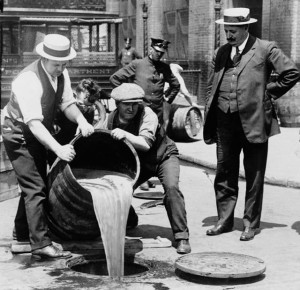The Origins of NASCAR
The inventive minds behind the creation of the first stock cars didn’t have sporting amusement on their minds when they pioneered the modification of early-era automobiles.
Nope, the good old southern boys of the 1920s had more pressing concerns than daydreaming about a future when their creations would spear one of the most popular spectator sports in the country. They were more worried about just eking out a living.
An illicit living.
NASCAR’s forefathers didn’t “soup up” their rides in order to outrun each other around an oval track in hopes of taking home the checkered flag.
On the contrary, the purpose was to outrun the law and get home with a few barrels of whiskey.
Yes, while other American sports are steeped in tradition (baseball) or immersed in warfare (football) the history of NASCAR is soaked in prohibition-era moonshine.
Earliest “Racers”
The earliest “stock car racers” were mostly located in the Appalachian region of the United States, where drivers modified their cars to improve speed and handling. The earliest “stock car races” took place down winding mountain roads and involved bootleggers attempting to outrun the police. With these modified early version stock cars, many of them succeeded.
The repeal of prohibition diminished the amount of bootleggers in operation, but by then a demand for moonshine had developed and many still transported moonshine while running from “revenuers” who wanted to tax them.
It is believed that while on these runs, many bootleggers would often race each other; creating the earliest stock car races.
First Stock Car Races
As the cars continued to get faster, these races became more and more organized. By the late 1930s and early 1940s organized stock car races where drivers competed for monetary prizes were taking place. What many regard as the earliest organized stock car races took place on March 8th, 1936 at Daytona Beach.
These races also began to grow in popularity and many promoters began to take notice. However, many of these promoters were less than savory characters and often would take advantage of the drivers by leaving with the profits of the race before it was over. Also, many promoters discriminated against drivers with prior involvement in bootlegging which, because these were typically the best drivers, greatly detracted from the quality of these races.
The Formation of NASCAR
There was one promoter, however, who envisioned a long term plan for stock car racing. This man’s name was William France and he actually came in fifth place in the aforementioned race at Daytona Beach.
Along with having a vision to grow the sport of racing through a sanctioning organization with standardized rules and regulations, he also saw an opportunity to provide a racing environment that accepted former bootleggers and produced a higher quality race. Through this vision, NASCAR was born on February 21st, 1948 and the rest was…well, history.
Reggie Sizemore has been a NASCAR fan for as long as he can remember and when he’s not watching his favorite driver (Dale Earnhardt Jr.), he’s taking in the beautiful sights on one of his long road trips. Reggie specializes in covering the car transport industry and currently writes on behalf of American Auto Move.

The expenses connected with this technique for transport are by and large higher than the open systems we will talk about next.
Ceramic engineering is the branch of science which deals with the study of creating new objects and that from inorganic and non- metallic materials through applying concepts of science and technology. This is because of superior papers reviews and knowledge and every person should get education.